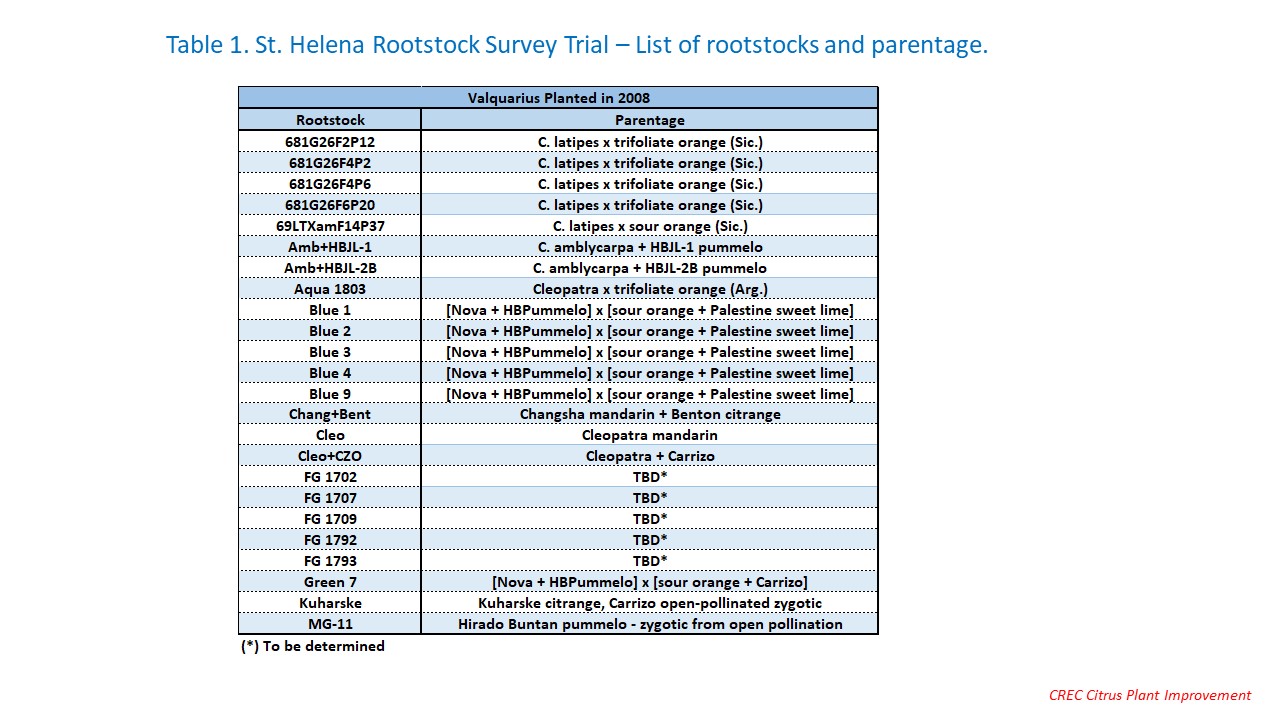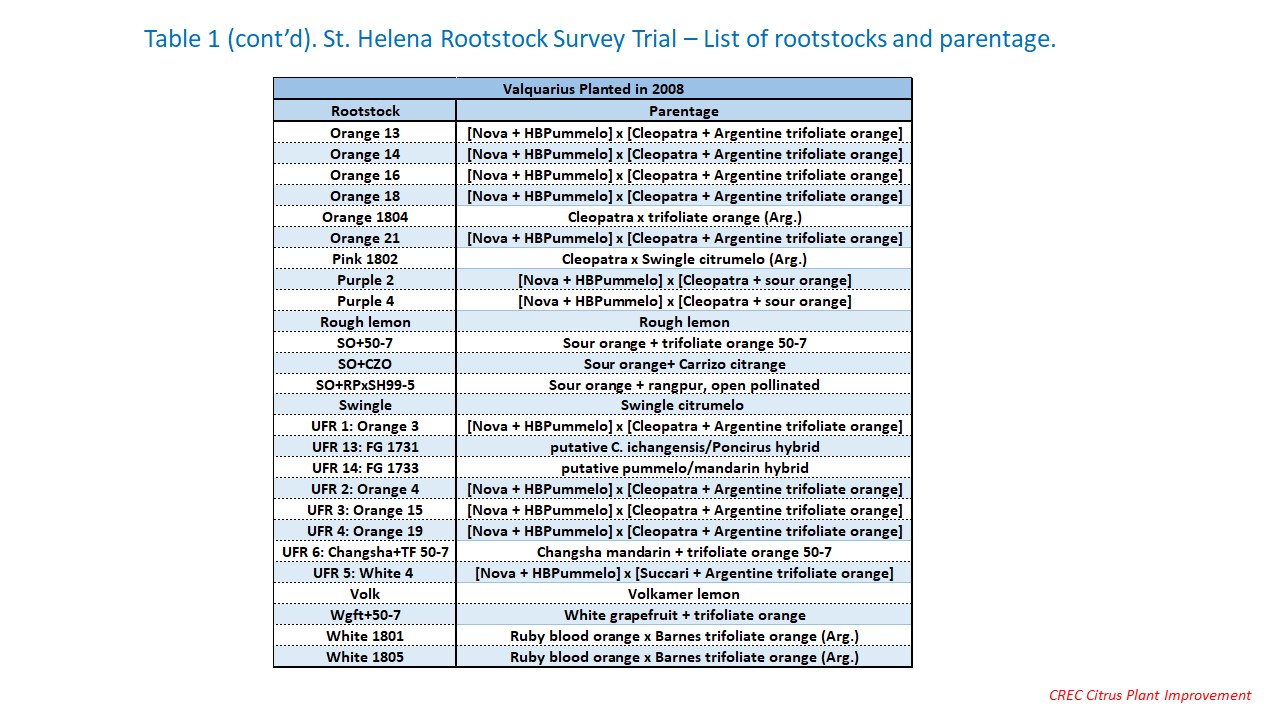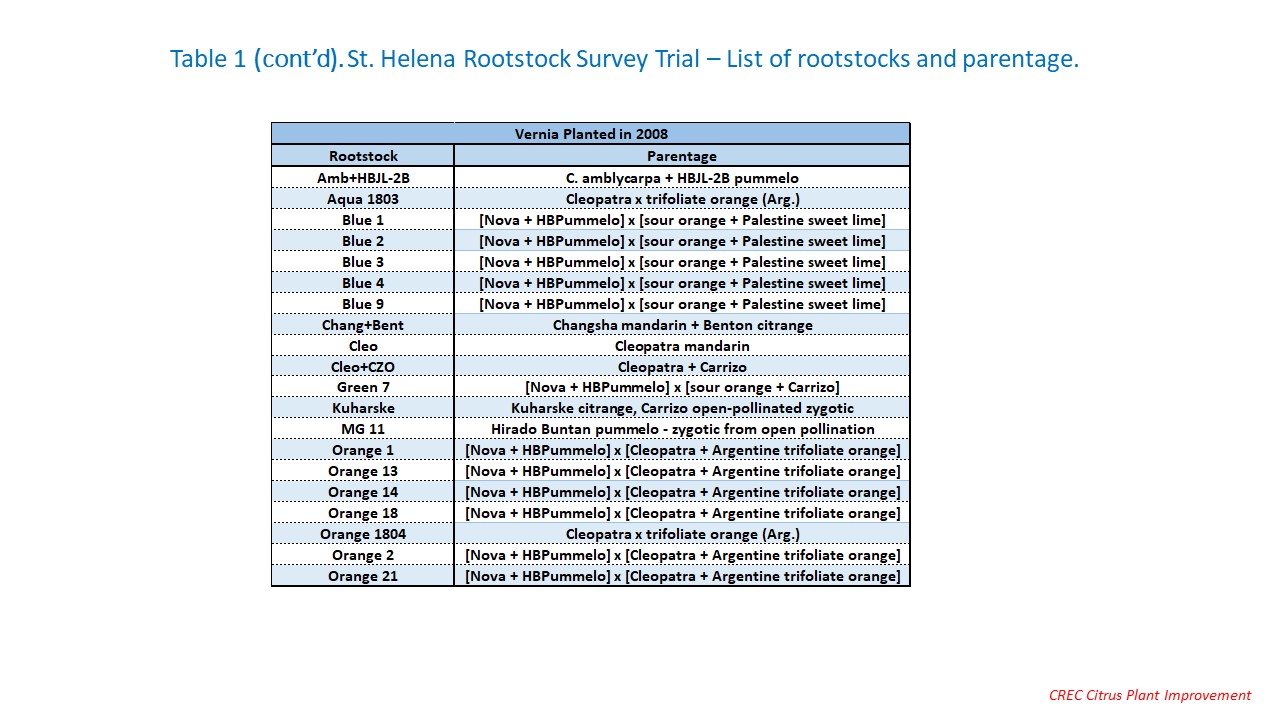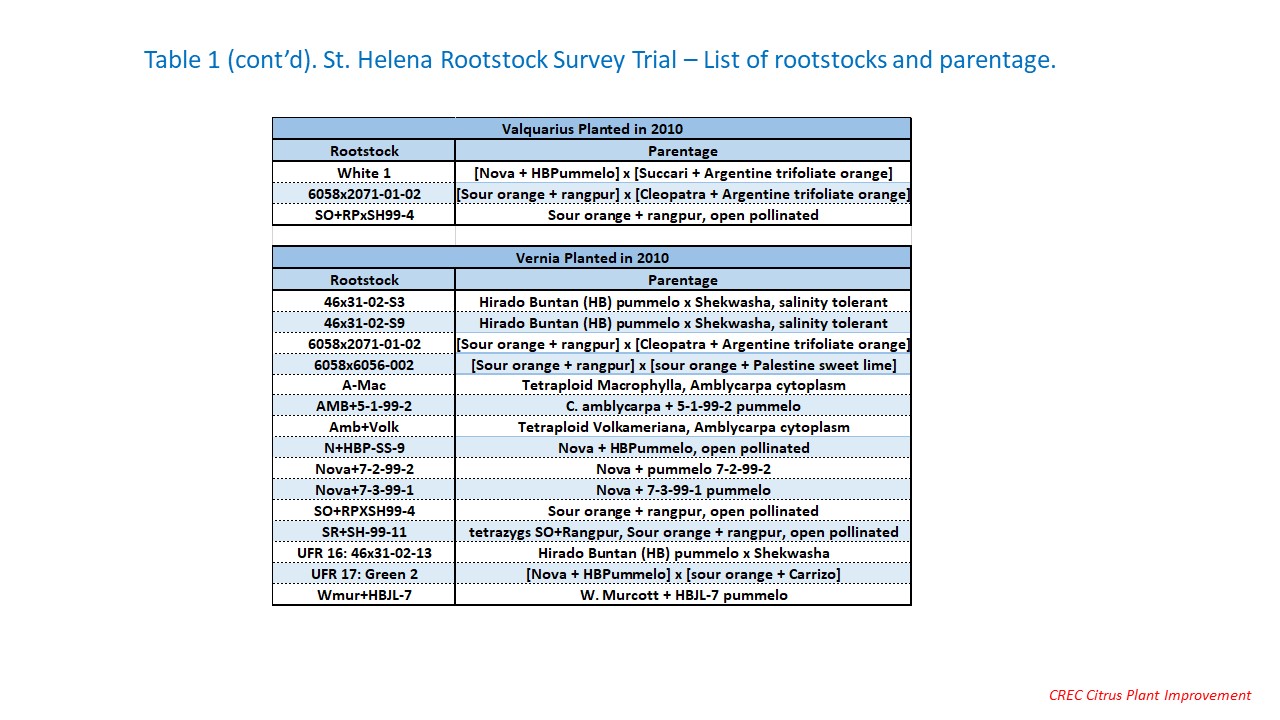St Helena Rootstock Survey Trial Addendum
What’s happening after 12 years with HLB?
(please see original St. Helena post for background information)
2018/19 vs. 2019/20 vs. 2020/21
Yield [boxes/tree] and Estimated PS/acre
Dr. Jude Grosser – Dr. Fred Gmitter – Dr. Bill Castle
Orie N. Lee and Lee Family Groves
August 13, 2021 – Addendum 1 updated
October 7, 2020 – Addendum 1 posted
CREC Citrus Plant Improvement
St Helena Rootstock Survey Trial - Summary
- Location: Dundee, Polk county
- Scions: Vernia & Valquarius
- Rootstocks: large collection of new diploid and tetraploid rootstocks
- Date planted: 2008 & 2010
- Design: According to the number of trees available
- Replications: variable per rootstock
- Plot size: 4-tree rectangular plots
- Spacing: 9 x 20; 12 x 20; 15 x 25 ft.
- Data:
- Yield (PS/box and PS/acre): 2018/19 to 2020/21
- Trial status: ACTIVE
St. Helena Rootstock Survey Trial Interpretive Summary (by Jude Grosser)
- This trial is providing some valuable insights regarding the long-term sustainability and profitability of various sweet orange/rootstock combinations. The trial has been grown using evolving Harrell’s CRF (controlled release fertilizer) formulations, with the latest change being implemented in the spring 2018 application, where the manganese and magnesium concentrations were increased. HLB has been present throughout, and HLB symptoms were observed after just one year (2009). Thus, it is especially relevant to look at the past three years of yield and fruit quality data to determine which rootstocks (grown with an enhanced micronutrient package) have passed through the disease ‘wave’ and are now consistently producing high yields of quality fruit.
- In my opinion, the best overall performing rootstock is the Orange 1804 (Cleo x trifoliate orange) from the Foguet program in Argentina. This rootstock has produced approximately 3 boxes of fruit and per tree with both Valquarius and Vernia scions the past three seasons. Although seedy, seed trees of this rootstock are not available in Florida. Efforts to import seed from Argentina have been hampered by regulatory issues. Thus, we are now working out arrangements with our colleagues in Argentina and with DPI to be able to safely import seed needed to establish larger plantings. It is note worthy that most of the rootstocks containing Cleo and trifoliate orange genetics are performing well. Vernia resets on x639, also a Cleo x trifoliate orange hybrid, have grown off beautifully.
- Three other rootstocks showing good promise are UFR-14 (FG 1733), the tetraploid somatic hybrid Amblycarpa + HBJL-2, and White 1 (a sibling of UFR-5). These three rootstocks excel for both yield and high soluble solids, and have shown good yields the past 3 seasons. Seed trees are also unavailable for these three rootstocks, but they are now through the PTP (Parent Tree Program), and TC (tissue culture) micropropagation is underway. The projected lbs. solids production/year at optimum planting density for these rootstocks and the Orange 1804 are above 3000 lbs. per acre, which would generate over $6,000 per acre gross revenue at $2/lb. solid. White 1 seed trees produce a mixture of zygotic and nucellar seeds, but the seed tree has been lost. White 1 is also performing very well in the Orie Lee trial in St. Cloud. White 1 has been established in TC, and is now being micropropagated by our TC companies for advanced trials. Unfortunately, the UFR-14 rootstock has been difficult to establish in TC. The first tree in the trial confirmed to have HLB, just 6 months after planting in 2008, was a Valquarius/UFR-14 tree; this tree has retained health and productivity, and still looks good today.
- There are a few rootstocks that excelled only with the Vernia scion; especially the somatic hybrids Cleopatra + Carrizo and Blue 1 (Nova+HBPummelo x Sour orange+Palestine sweet lime). Cleo + Carrizo makes a smaller tree, and produces very high lbs. solids. It can be propagated by seed, but the seed fruit only contains 1-3 seed per fruit; thus TC may be a better option. This rootstock has also shown potential to reduce fruit granulation, and a test has been set up to see if it can help with the Florida navel orange problem of granulation and low solids. Blue 1 makes a large tree, and has also shown promise in another trial in the Indian River. It can be propagated by seed. Both rootstocks are being considered for commercial release, and both are in the PTP. Both have also been established in TC by our cooperating TC companies.
- Most of the rootstocks from the Foguet program (Argentina) have been quite impressive, and are a tribute to the great career of rootstock breeder José Luis Foguet. In addition to Orange 1804, Aqua 1803 and White 1805 merit further consideration, but also face the seed importation problem.
- The UFR rootstocks in the trial continue to perform reasonably well, and the tetraploids UFR-1,2,4,5,6 & 17 have been reliable and can be profitable if planted at the optimal planting density. UFR-1 trees have consistently shown good color with very full canopies; yields and fruit quality have also been good. UFR-1 is also performing well in our trial at Orie Lee’s in St. Cloud. It has been underplanted commercially, but seed is available. UFR-6 continues to show promise for higher density plantings, and routinely produces fruit with outstanding quality, usually above 7.0 lbs. solids per box. UFR-15 (not included in the original two plantings) has been planted at St. Helena as resets, and the trees have grown off vigorously with dark green color and full canopies, and these vigorous trees have set a good crop for this season. UFR-15 makes larger trees than the other available UFR rootstocks, and it is a good candidate for resets in groves with traditional tree spacings. UFR-15 seed is available.
- The improved controlled release fertilizer formulation has also significantly impacted the recent performance of the commercial control rootstocks, as rough lemon, Kuharske, Swingle and Cleo have all shown improved tree health and yields over the past two seasons. It is intriguing to think what might be possible if such trees are provided a constant supply of the enhanced micronutrient package from the get-go.
We have identified some standout trees that have grown vigorously resulting in healthy trees with full canopies and dark green color. Such trees have yielded 3-3.5 boxes/tree and juice with 12.0-12.5 Brix. These trees are on seed-derived rootstocks from seed trees that produce frequent zygotic seedlings. We have hypothesized that these standout trees could be on unique hybrid rootstocks. Initial efforts to sprout the trees without losing the scions were unsuccessful, so we recently cut the tops of the trees off. They are just now beginning to sprout (July, 2021). Our plan is to recover the rootstock genotype from each tree, and then run a molecular marker test to determine if each rootstock is indeed a zygotic (by comparison to the mother tree genotype). Any rootstock proven to be a unique zygotic will be cleaned up to generate pathogen-free material, then propagated by rooted cuttings and TC for advanced trials. Six trees were selected and cut, including two from HBPummelo x Shekwasha mandarin, and two from MG-11. One of the MG-11 trees produces very large fruit (pre-HLB size), and this tree also had the highest ct value (meaning the lowest CLas bacterial titer via qPCR test).

.jpg)




